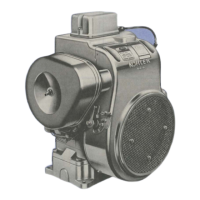BA
TTERY
: Use 12 vol t nega
tive
battery
(- t erm
in
al
ground) with
amp
hour ra t ing
of
at
least 32
for
be
st
resu
l
ts
.
Whe
n bat t ery
is
in
good condi
tion,
each
cel
l
contr
ibutes
approxima
tel
y 1.95 to 2. 08
volts
. If
the charge
is
low and
less
than 0.05
volt
difference
is not ed between the
cells
having
the
highest and
lowest read
ings,
the ba
ttery
should be recharged.
If
t he di fference is more than .05
volts,
t
his
could
indicate
a cracked
plate
or
other
damage
which could
call
f
or
replacement of the
bat
tery
.
A
regulator
may
be
bl
amed
for an undercharged or
repeatedly
discharged
battery
when
the
fault
is
actually
self-discharge
caused by a
build
-up
of
corrosive
acid
across
the
to
p
of
the
ba
tte
ry.
Even a
light
coating
of
this
grayish-white
substance can complete a ci rcuit to
drain
and exha
ust
the energy
in
the
battery--this
can be
especially
bad
when
moisture i s
present
. Service as
in
di
cated
in
the following.
To maintain a
battery
in
top
condition
, check and perform the following
services
at
frequent in
ter
-
vals:
1. Regularly check l evel
of
electrolyte--add
water as necessary to maintain
leve
l above
plates
--do
not
overfill
as
this
can cause poor performance
or
early
failure
due to
loss
of
e
lectrolyte
.
2.
Keep
terminals
and
top
of
battery
clean
.
Wash
with
baking soda and
rinse
w
ith
clear
water. Do
not allow soda
solution
to
enter
cells
as
this
will
destroy
the
electrolyte.
starting
motor
Precautions:
In
the
event
of
a
"false
start"
(engine
gets
up
sufficient
speed to disengage
starter
but
fa1ls
to
ontinue running),
the
engine
mus
t be completely stopped before another
starting
attempt
is
made
.
If
the
flywheel
is
still
rotating,
the
drive
pinion
and
ring
gear
will
clash
and be
damaged.
Limit cranking (continuous)
to
a
period
of
30 seconds to
prevent
overheating
of
the
starter.
If
cranked
for
30 seconds,
starter
should not be operated
again
for
60 seconds
to
allow time
for
cooling.
Starting
mot ors do
not
require
service
at
any
specific
intervals.
They
are
pre-lubricated
during
manufacture and brushes normally
require
a
ttention
only
after
extensive
use--see
trouble
analysis
below.
Connections
to
starting
motor should be checked
occasionally
to
make
sure
they
are
tight
and
that
leads
are
in good cond
ition.
The following
precautions
should be observed on
electric
star
t models
to
prevent
starter
damage
and/or
depletion
of
battery
energy.
Trouble Analysis:
If
starter
fails
to
energize,
first
check wiring,
starting
switch or
solenoid
and
condition
of
battery.
Clean
or
replace
badly corroded
or
dirty
contacts--replace
wires
if
frayed or
cracked. Bypass
start
switch
or
solenoid
with
jumper
wire--if
starter
cranks normally,
replace
defective
switch or
solenoid.
If
starter
turns
too slowly and
battery
is
in good
condition,
check
for
dirty
brushes or commutator.
Further
trouble
analysis
will
require
special
test
equipment
available
only
at
authorized
repair
stat
ions.
Alignment: Alignment
of
starter
pinion
to
ring
gear
is
established
by
the
machined
surface
of
starter
mounting flange on the
side
of
the
cylinder
block and through
special
mounting
bolts
. To
prevent
mis-
alignment and
gear
damage,
make
sure
the
proper shoulder
bolts
are
used and
that
they
are
securely
tightened
at
all
times.
carburetor
adiustments
Carburetors
are
calibrated
in
the
factory
and the main
fuel
system cannot be
reset.
If
black exhaust
smoke
is
noted, check
the
air
cleaner--an
"overrich"
mixture
is
usually
caused by a poorly
serviced,
clogged
air
cleaner
element.
If
idle
readjustment becomes
necessary,
stop
the
engine, then
turn
the
IDLE
fuel
adjusting
screw,
all
the
way
in
until
it
bottoms
lightly--don't
force
it
closed
as
this
will
damage
the needle
valve.
For
preliminary
settulg,
turn
the
IDLE
1-1/4
turn
out
. For
final
adjustments,
start
engine and allow
it
to
warm.
The
IDLE
fuel
can then be
set
by
turning
the adjustment in
until
the
engine slows
down.
Now
turn
the
screw
out--the
engine
will
regain
speed
at
first
and then
it
will
slow
down-
-note the
positions
of
screw
at
both
settings
, then
set
it
about
half
way
between
the
two.
governor
adiustments
The governor
functions
to
maintain engine speed under changing load
conditions
and
also
acts
as a
speed
limiting
device . Governors
are
set
in
the
factory
and
further
adjustments should
not
be
required
unless
linkage works loose
or
becomes disconnected. Readjustment should be
made
if
t he engine surges
with
changing load or
if
speed drops
considerably
when
a normal load
is
applied.
Readjustment should be made
by a qua
lified
person only.
8

